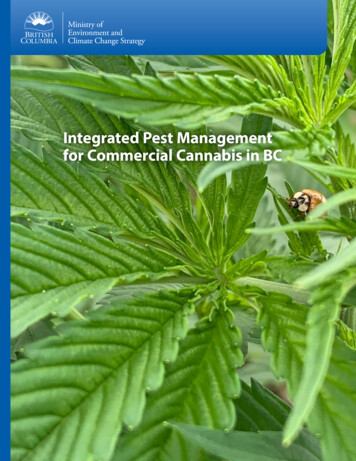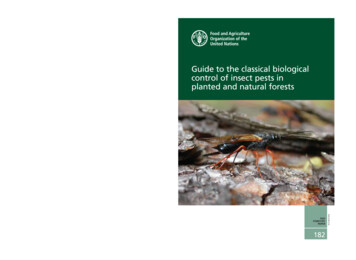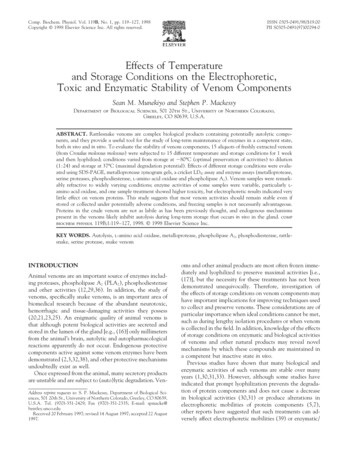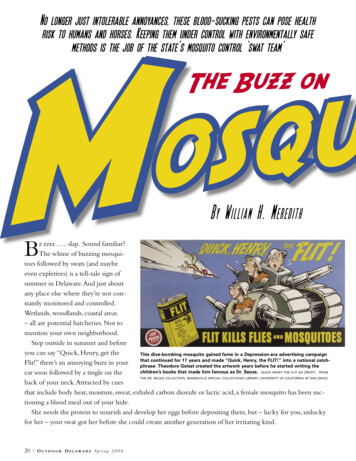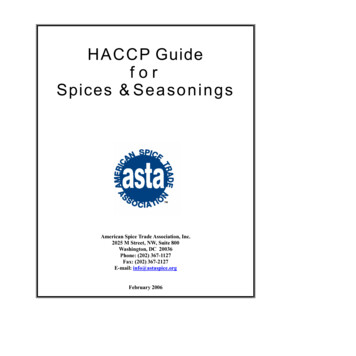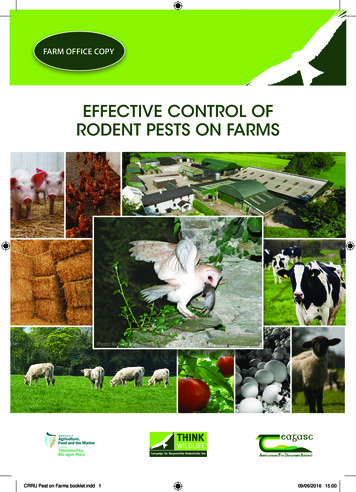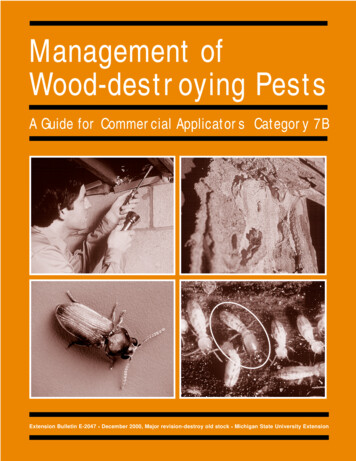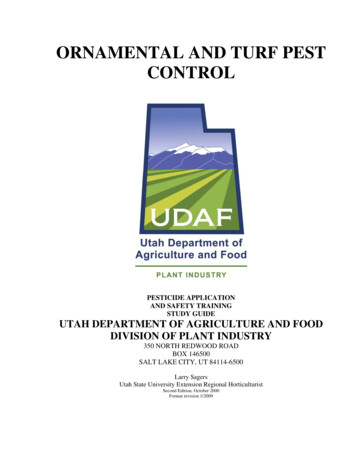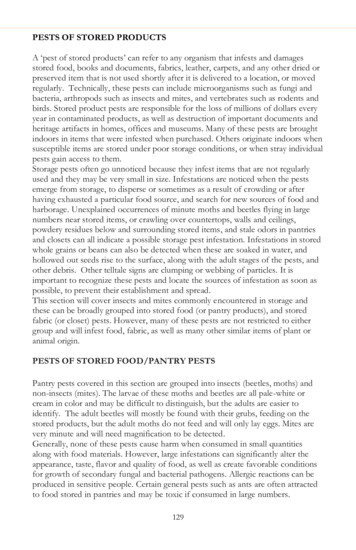
Transcription
PESTS OF STORED PRODUCTSA ‘pest of stored products’ can refer to any organism that infests and damagesstored food, books and documents, fabrics, leather, carpets, and any other dried orpreserved item that is not used shortly after it is delivered to a location, or movedregularly. Technically, these pests can include microorganisms such as fungi andbacteria, arthropods such as insects and mites, and vertebrates such as rodents andbirds. Stored product pests are responsible for the loss of millions of dollars everyyear in contaminated products, as well as destruction of important documents andheritage artifacts in homes, offices and museums. Many of these pests are broughtindoors in items that were infested when purchased. Others originate indoors whensusceptible items are stored under poor storage conditions, or when stray individualpests gain access to them.Storage pests often go unnoticed because they infest items that are not regularlyused and they may be very small in size. Infestations are noticed when the pestsemerge from storage, to disperse or sometimes as a result of crowding or afterhaving exhausted a particular food source, and search for new sources of food andharborage. Unexplained occurrences of minute moths and beetles flying in largenumbers near stored items, or crawling over countertops, walls and ceilings,powdery residues below and surrounding stored items, and stale odors in pantriesand closets can all indicate a possible storage pest infestation. Infestations in storedwhole grains or beans can also be detected when these are soaked in water, andhollowed out seeds rise to the surface, along with the adult stages of the pests, andother debris. Other telltale signs are clumping or webbing of particles. It isimportant to recognize these pests and locate the sources of infestation as soon aspossible, to prevent their establishment and spread.This section will cover insects and mites commonly encountered in storage andthese can be broadly grouped into stored food (or pantry products), and storedfabric (or closet) pests. However, many of these pests are not restricted to eithergroup and will infest food, fabric, as well as many other similar items of plant oranimal origin.PESTS OF STORED FOOD/PANTRY PESTSPantry pests covered in this section are grouped into insects (beetles, moths) andnon-insects (mites). The larvae of these moths and beetles are all pale-white orcream in color and may be difficult to distinguish, but the adults are easier toidentify. The adult beetles will mostly be found with their grubs, feeding on thestored products, but the adult moths do not feed and will only lay eggs. Mites arevery minute and will need magnification to be detected.Generally, none of these pests cause harm when consumed in small quantitiesalong with food materials. However, large infestations can significantly alter theappearance, taste, flavor and quality of food, as well as create favorable conditionsfor growth of secondary fungal and bacterial pathogens. Allergic reactions can beproduced in sensitive people. Certain general pests such as ants are often attractedto food stored in pantries and may be toxic if consumed in large numbers.129
INSECTS: BEETLESCommon name(s): Bean weevil, seed beetle, pulse beetleScientific name, classification: Acanthoscelides spp., Callosobruchus spp., Order:Coleoptera, Family: Chrysomelidae.Distribution: Worldwide.Description and ID characters: Smallbeetles, ⅛ - ¼ inch in length, with stout,rounded oblong bodies, generally coloredgrayish brown or dark gray with mottledpatterns. Although they are called ‘weevils’,they lack the characteristic elongated snoutfound in true weevils (Family Curculionidae).Larvae are small plump, yellowish-creamcolored, legless grubs.Best identifying features: Short elytra(hardened front wings that form a shell overthe top of the body) with flattened ends,which do not cover the tip of the abdomen.Bean beetlesHead is small, black and bent downwards.Photo: Patrick Marquez, Bugwood.orgEntire body is clothed with fine, short hairs.Eyes are large and protruding. Antennae are well developed, often as long as orlonger than the front legs, with flattened leaf-like segments towards the tip. Adultbeetles are capable of flight, and will fly out in large numbers when infested beansare disturbed.Pest status: Important pest of stored legumes such as peas and beans, andoccasionally grains and other foods. Will also attack legume pods on standing cropsin the field.Damage/injury: Adults and grubs bore into seeds and feed on the contents. Neat,circular exit holes can be seen ondamaged seeds. Heavy infestation causesthe stored beans to heat up, resulting inmold growth and change in flavor andtaste. They can chew through plastic andpaper bags to reach stored food.Life history: Eggs are laid and stuck onto the surface of beans seeds, and can beseen as minute white spots. Each seedmay have several eggs on its surface.Eggs can be laid on the beans in the field,Eggs, exit holes and adults on beans Photo:Originality1988before harvest. Emerging larvae boreinto the seeds and feed on the kernels,and feed on several seeds before pupating. Larvae ready to pupate will chew around hole on a seed to emerge as adults, and then pupate inside the seed. Pupaeare small and dark brown in color. Duration of life cycle is highly dependent ontemperatures, and takes 3-4 weeks at temperatures above 30oC; longer duringcooler months. 5-6 generations are possible in a year.130
Common name(s): Rice weevilScientific name, classification: Sitophilus oryzae,Order: Coleoptera, Family: Curculionidae. Tworelated species, the maize weevil or greater riceweevil Sitophilus zeamais, and the wheat weevil orgranary weevil Sitophilus granarius are also verycommon; the 3 species are often mistaken for eachother.Distribution: Worldwide.Rice weevil adultDescription and ID characters: Small darkPhoto: Joseph Berger, Bugwood.orgbrown, reddish-brown or black elongated weevils,about 1/16 inch in length. Larvae are small plump,yellowish-cream colored grubs.Best identifying features: Pronounced snoutprojecting in front of the head, bearing elbowedRice weevil adultantennae with club-shaped tips. MicroscopicPhoto: Natasha Wright, Bugwood.orgexamination shows four reddish-brown or orangepatches on the corners of the wings in rice weevilsand maize weevils (marks on top of wings arefainter), which are also both capable of flight. Thegranary weevil lacks these marks, and is not capableMaize weevil adultof flight. Adults of all species will go motionless,Photo: Natasha Wright, Bugwood.orgwithdrawing their legs close to their bodies and playdead when disturbed. Grubs of all species aresmall, ‘C’ shaped, plump cream colored, leglesslarvae.Pest status: Important pest of several stored foodGranary weevil adultgrains, mainly rice, wheat, corn and their productsPhoto: Jennifer C. Giron Duquesuch as breakfast cereals, macaroni, noodles, etc.Adult rice and maize weevils can attack standinggrain crops in the field before harvest. All species can also attack other foodmaterials such as dried fruits and nuts.Damage/injury: Adults chew on grain and feed onthe contents leaving the hulls if present, while thegrubs develop within them. Together, they reducethe infested grain over time to a coarse, stalesmelling powder. Individual infested grains haveirregular feeding marks, and some are partiallyhollowed out. Heavy infestation causes the storedgrains to heat up, resulting in mold growth andRice weevil larvaePhoto: Pest and Disease Image Librarychange in flavor and taste. They can chew throughplastic and paper bags to reach stored food.Life history: Females chew a small hole on the surface of a grain, lays a single eggwithin it and seals the hole with a waxy secretion. The hatching grub feeds withinthe grain till pupation, and emerges as an adult by breaking open the almosthollowed out grain. Duration of life cycle is highly dependent on temperatures,131
and takes 3-4 weeks at temperatures above 30oC; longer during cooler months. Upto 10 generations are possible in a year.Common name(s): Cigarette beetleScientific name, classification: Lasiodermaserricorne, Order: Coleoptera, Family:Anobiidae.Distribution: Worldwide.Description and ID characters: Smallreddish-brown, stout and rounded beetle,about 1/16 inch in length, with an ovaloutline.Best identifying features: Head and thoraxCigarette beetle adultsbent downwards almost perpendicular to thePhoto: Pest and Disease Image Librarybody, head is not visible when viewed fromthe top. Elytra are almost smooth, or with very faint grooves. Body is clothed withfine, short hairs. Antennae are short and of uniform thickness throughout theirlength. Larvae are small plump, creamy-white, legless grubs with a small yellowishbrown head, and covered with yellowish-brown silky hairs.Cigarette beetles are very often confused with the drugstore beetle, which belongsto the same family and often attacks similar stored products. However, drugstorebeetles have elytra with deep lengthwise grooves; their antennae end in a 3segmented club and their larvae have shorter hairs. If viewed together, drugstorebeetles may be slightly larger and more elongated, while cigarette beetles may beshorter and rounded.Both these beetles are also confused with another common beetle belonging tofamily Anobiidae, the common furniture beetle Anobium punctatum, which may belonger than both, darker in color, with a pronounced hump or upward projectionon their pronotum, resembling a hood.Pest status: Important pest of stored tobacco and various other dried herbs andspices, as well as many other stored products such as dried fruits and nuts, cereals,oilcakes, flour, bone meal, dried flowers, etc.Damage/injury: Tobacco is the preferredfood of cigarette beetles, which gives themtheir common name. All harvested, driedand processed forms of tobacco areattacked, which include raw dry bales,refined cigarettes, cigars, and chewingtobacco. Adult beetles and grubs borethrough the leaves and leaving holes andultimately reducing the tobacco to a fineCigarette beetle pupa, adult and larva on apowder. They also attack and destroydamaged cigarmany other stored products in a similarPhoto: Clemson Univ.-USDAmanner.Life history: Eggs are laid loosely on the stored product, and the hatching grubsand adults together feed on the material till it is exhausted. Pupation is also takesplace among the food product. Mature larvae create a small cocoon with particles132
of the substrate and their saliva, and pupate within it. Duration of life cycle ishighly dependent on temperatures, and takes 3-4 weeks at temperatures above30oC; longer during cooler months. 5-6 generations are possible in a year.Common name(s): Drugstore beetle, breadbeetle, biscuit beetleScientific name, classification: Stegobiumpaniceum, Order: Coleoptera, Family:Anobiidae.Distribution: Worldwide.Description and ID characters: Smallreddish-brown, elongated beetle, about ⅛ 1/ inch in length, with elongated-oval16outline.Drugstore beetle adultsBest identifying features: Head and thoraxPhoto: Pest and Disease Image Librarybent downwards almost perpendicular to thebody, head is not visible when viewed from the top. Elytra have distinct and deeplengthwise grooves. Body is clothed with fine, short hairs. Antennae are short andend in a 3-segmented club. Larvae are small, plump, creamy-white, legless grubscovered with short, silky hairs.Drugstore beetles are very often confused with the cigarette beetle, which belongsto the same family and often attacks similar stored products. However, cigarettebeetles have elytra that are almost smooth or with very faint grooves; theirantennae are of uniform thickness throughout the length, and their larvae arecovered with long, yellowish-brown silky hairs. If viewed together, drugstorebeetles may be slightly larger and more elongated, while cigarette beetles may beshorter and rounded.Both these beetles are also confused with another common beetle belonging tofamily Anobiidae, the common furniture beetle Anobium punctatum, which may belonger than both, darker in color, with a pronounced hump or upward projectionon their pronotum, resembling a hood.Pest status: Important pest of various dried herbsand medicinal plants, as well as various other driedherbs and spices, tobacco, dried fruits and nuts,cereals, book bindings, leather, etc.Damage/injury: These beetles have a preferencefor dried herbs and other medicinal plants and arecommon in prescription drug preparations, givingthem their common name. However, they actuallyattack a wider range of stored products thancigarette beetles, and are even known to borethrough aluminum, tin and lead sheets. They alsoinfest bird or rodent nests near homes andbuildings. Adult beetles and grubs bore throughLarvae of cigarette (above) andthe stored product leaving small holes anddrugstore (below) beetlesultimately reducing it to a fine powder. AdultPhoto: Pest and Disease Image Librarybeetles often chew small shot-holes on packaging133
of stored products to emerge, causing some of the powdery remains within to spillout.Life history: Eggs are laid loosely on the stored product, and the hatching grubsand adults together feed on the material till it is exhausted. Pupation is also takesplace among the food product. Mature larvae create a small cocoon with particlesof the substrate and their saliva, and pupate within it. Duration of life cycle ishighly dependent on temperatures, and takes 3-4 weeks at temperatures above30oC; longer during cooler months. 5-6 generations are possible in a year.Common name(s): Khapra beetle, cabinet beetleScientific name, classification: Trogodermagranarium, Order: Coleoptera, Family:Dermestidae.Distribution: Worldwide.Description and ID characters: Small darkbrown, stout, rounded oval shaped beetle,about 1/16 inch in length.Best identifying features: Closerobservation will reveal that the body iscovered with short, dense hair. Indistinctreddish-brown or lighter brown patterns mayKhapra beetle adultsbe present on the elytra. The head may bePhoto: Pest and Disease Image Libraryvery slightly visible when viewed from thetop, it is bent downwards and is almost fullycovered by the pronotum. Antennae are shortand end in a 3- or 5-segmented club.Larvae are about ¼ inch long, with ayellowish-white, distinctly segmented bodycovered with short, stiff hairs. The hairstowards the tail end are longer. The larvaeturn golden or reddish-brown as they mature.Khapra beetle larvaPest status: Important pest of storedPhoto: James D. Young, USDA APHIS PPQproducts. One of the world’s most destructiveand invasive stored product pests, on quarantine list in many countries includingthe U.S. Any suspected occurrences should be reported to the state regulatoryagencies.Damage/injury: Khapra beetlesattack a large number of storedproducts of plant and animal origin,but prefer grain and cereal productssuch as whole grains, flour, noodles,and similar items. The larvae aremore damaging than the adults. Instored grains, they are known tofeed partially on one grain beforeKhapra beetle adult and larvae damaging stored wheatstarting on the next one, and thus aPhoto: Ministry of Ag. And Regional Developmentsingle beetle can damage a large134
quantity of the grain. Adult beetles readily chew through plastic and paperpackaging to reach food sources. Heavy infestations can cause stored products toheat up leading to mold growth, and reduction in flavor and quality of food items.Life history:Adult beetles rarely fly and feed very little during their short lifespan of about 14-30days. Eggs are laid loosely in the food source and the hatching larvae immediatelybegin to feed. They pass through several molts before turning into adults.Development is highly influenced by environmental conditions, and the larvae canremain dormant for many years under unfavorable conditions. They can crawl intotiny spaces, which also protect them from insecticides or other treatments aimed atstored product pests. Khapra beetles prefer low humidity (less than 2%) and arepoorly adapted to high humidity. This increases the risk of their spread in the hotand dry conditions in the arid southwest. Therefore it is very important torecognize the pest and take appropriate quarantine measures if they are noticed.Introduction and spread is almost always by human activities because the adultsrarely fly.Common name(s): Flour beetlesScientific name, classification: Tribolium spp., Order: Coleoptera, Family:Tenebrionidae. The confused flour beetle T. confusum and the red flour beetle T.castaneum are the most commonly occurring species.Distribution: Worldwide.Description and ID characters: Small,slender, flattened and elongated, reddishbrown beetles, about ⅛ inch in length.Best identifying features: Both speciesare flattened, elongated reddish-brownbodies; head and thorax have minutepunctures, elytra have lengthwise ridgesand punctures between the ridges. Thethorax is more-or-less rectangular in shape,Confused flour beetleand the margins lack teeth.Photo: SarefoConfused flour beetles have antennaethat gradually enlarge towards the tip andend in a 4-segmented club. The thorax isslightly broader towards the head thantowards the abdomen, but edges are almoststraight.Red flour beetleRed flour beetles have antennae thatPhoto: Natasha Wrightabruptly enlarge at the tip to form a 3segmented knob. The thorax has rounded edges, and slightly wider at the middle.Pest status: Important pest of a wide range of stored grains and their productssuch as cereals and flour.Damage/injury: Do not usually damage whole grains, but found more in brokenbits and flour, or grain previously infested by other pests. The damage is less due tofeeding, but more due to contamination of the stored product with large numbersof various life stages, dead bodies, cast skins and fecal pellets. They also produce135
pungent substances during their activities that can seriously affect the quality ofgrain and result in reduced marketability and consumption by humans andlivestock. Heavy infestations also cause heat buildup in storage containers,resulting in secondary mold growth.Red flour beetles infesting cornRed flour beetle life stagesPhoto: Western Australia Dept. of Ag.Photo: Pest and Disease Image LibraryLife history: Eggs are laid loosely on the stored product, and the hatching grubsand adults together feed on the material till it is exhausted. Pupation is also takesplace among the food product and pupae are not enclosed in cocoons. Duration oflife cycle is highly dependent on temperatures, and takes 6 weeks at temperaturesabove 30oC; longer during cooler months. Up to 10 generations are possible in ayear. Adults are very active and long lived, mostly surviving up to 1 year or more.Common name(s): Saw-toothed grain beetleScientific name, classification: Oryzaephilus surinamensis, Order: Coleoptera,Family: Silvanidae. A related species, themerchant grain beetle O. mercator is also verycommon; the 2 species are often mistaken foreach other.Distribution: Worldwide.Description and ID characters: Small, slender,flattened and elongated beetle, colored darkbrown, about ⅛ inch in length.Best identifying features: 6 saw-tooth likeprojections along both side margins of thepronotum (thorax). Short connecting segmentbetween the thorax and abdomen. Elytra areelongated with rounded ends and rows of minutepuncture-like depressions, and completely coverSaw-toothed grain beetlePhoto: Pest and Disease Image Librarythe abdomen. Prominent eyes and long antennae.Larvae are yellowish-white with brown head, andelongated worm-like body with sparse hairs. 3 pairs of short legs can be seen onthe thorax.The merchant grain beetle is almost identical, except for larger eyes that are locatedfurther away from the neck than in the saw-toothed beetle.Pest status: Important pest of a wide range of stored products of plant or animalorigin.136
Damage/injury: Attack a large number of storedproducts within the pantry and surroundingrooms. Feeding on germ region of stored seeds isreported to reduce germination. Adult beetles andgrubs bore through the stored product, andSaw-toothed grain beetle larvaleaving holes and ultimately reducing it to a finePhoto: Mohammed El Damirpowder. Adult beetles readily chew through plasticand paper packaging to reach food sources.Heavy infestations can cause stored products to heat up leading to mold growth,and reduction in flavor and quality of food items.Life history: Eggs are laid loosely on the stored product, and the hatching grubsand adults together feed on the material till it is exhausted. Most of the larvae arefound in the top 2-3 inches of the stored material. Pupation is also takes placeamong the food product. Mature larvae create a small cocoon with particles of thesubstrate and their saliva, and pupate within it. Duration of life cycle is highlydependent on temperatures, and takes 3-4 weeks at temperatures above 30oC;longer during cooler months. 5-6 generations are possible in a year.Common name(s): Spider beetlesScientific name, classification: Ptinus spp.,Mezium spp., Gibbium spp., Order: Coleoptera,Family: Anobiidae, subfamily Ptininae (sometimesas family Ptinidae). The smooth spider beetleGibbium aequinoctiale, the American spider beetleMezium americanum and the whitemarked spiderbeetle Ptinus fur, are common species.Distribution: Worldwide.Description and ID characters: Small, globularSmooth spider beetlebrown or black beetles, some with patterns, aboutPhoto: Sarefo⅛ - ¼ inch in length.Best identifying features: Spider-like appearance due to relatively large, globularpear-shaped abdomens and long legs. Elytrafully covers the abdomen. Head is pointeddownwards and is hidden when viewed from thetop.Smooth spider beetles are slightly over ⅛ inchin length, with shiny dark reddish-brown,abdomen and long, light-brown legs andantennae.American spider beetles are about ⅛ inch inlength. Head and thorax are dull yellow andhairy, thorax is almost cylindrical with bluntprojections on either side, elytra are glossy darkAmerican spider beetlePhoto: Pest and Disease Image Libraryreddish brown or black. Antennae and legs arelong and slender, and pale yellow or light brownin color.137
Whitemarked spider beetles are about ¼ inchin length, and light reddish brown in color, withpatches of white hairs on the elytra. Females have2 white patches on each elytron that join to formtwo transverse bands. Legs and antennae are long,slender and pale yellow in color.Larvae of all species are small, plump and Cshaped, legless grubs with light brown heads.Adult spider beetles are sometimes confused withbed bugs, but can be easily distinguished on closerexamination.Whitemarked spider beetlePest status: Scavenger and occasional pest of aPhoto: Pest and Disease Image Librarywide range of stored products, predominantlycereal products.Damage/injury: Spider beetles are generalscavengers and feed on a wide variety of fooditems. Occasional infestation of woodenstructures near food sources is reported, in wallvoids and drop ceilings. Larvae cause a typical"scarring" of the wood in buildings in theformation of pupal cells prior to pupation. TheySpider beetle larvado not bite or sting humans or pets, or spreadPhoto: Pest and Disease Image Librarydiseases.Life history: Eggs are laid in stored products, on outside of packaging or in debrisfound in cracks and crevices of storage structures. Larvae feed on the availablefood sources and bore into nearby wood or cardboard structures to pupate. Somespecies overwinter in the larval stage, and pupate in the following spring, whilesome are active year round. 2-3 overlapping generations are possible in a year.Common name(s): Yellow mealwormScientific name, classification: Tenebrio molitor,Order: Coleoptera, Family: Tenebrionidae.Distribution: Worldwide.Description and ID characters: Some of thelargest stored product insects. Adults are shinydark brown or black beetles, about ½ - ¾ inchlong. They usually emerge in early summer and flyto lights.Best identifying features: The thorax in adults isYellow mealworm adult beetlecovered with fine punctures and the elytra havePhoto: Clemson Univ.-USDAlongitudinal grooves.Larvae are slender, pale yellow at first and turningdark yellow and about 1 inch long when mature, with each segment borderedyellowish brown.Pest status: Occasional pests of stored grains and other stored products.Damage/injury: Mealworms feed externally on stored grains and do not bore intothem or cause webbings. Therefore they are not considered serious pests, but they138
can cause damage and contaminate the storedproducts with their feces and cast skins. However asevere infestation can destroy large quantities ofstored products especially when unnoticed for along period of time.Life history: Adults emerge in late spring or earlyYellow mealwormsummer. Eggs are laid and glued to the food source.Photo: Clemson Univ.-USDALarvae feed continuously through the summer andinto the fall and overwinter as larvae. They pupate in spring, and emerge as adultsin about 2 weeks. Due to overwintering in the larval stage, only 1 generationusually occurs in a year.INSECTS: MOTHSCommon name(s): Angoumois grain mothScientific name, classification: Sitotroga cerealella, Order: Lepidoptera, Family:Gelechiidae.Distribution: Worldwide.Description and ID characters: Adultmoths are small, slender, dark tan, buff orstraw-colored moth, about 1 3 inch inlength and wingspan of ½ inch.Best identifying features: Back edges ofboth pairs of wings have a fringe of hairs.Both pairs of wings end in a finger-likeprojection, which is more distinct in thehind wings.Angoumois grain moth adult. Note fringesLarvae are creamy white with a darkalong back edges of wings and finger-likehead. Pupae are reddish brown andprojection at the tip of wingsPhoto: CSIROenclosed in a silken cocoon.Damaged grains show circular holes, similar to those made by certain beetle pestsof stored grains such as the rice weevil or maize weevil. Locating the adults isnecessary to confirm the source of damage.Pest status: Occasional pest of stored grains and other food products, and also ofgrains (especially corn) in the field.Damage/injury: Damage is caused entirely by the larvae. They bore into thekernel of grains and usually spend the entire larval stage and pupation within thekernel. Damaged kernels are hollow and often have a round exit hole throughwhich the adult emerged. Infested grains will not germinate. They have anunpleasant smell which makes them unfit for consumption by humans or livestock.Infestation can increase moisture content and temperature of the stored products,attracting mold and other microorganisms. The adult moths do not feed on ordamage stored products, but only visit to lay eggs. Stored ear corn is much moresusceptible to attack than shelled corn. Infestations can start in the field before thegrains are harvested, or can be acquired from existing stored grains.139
Life history: Eggs are laid and glued to the surface of the grains, mostly while stillin the field. The hatching larvae immediately bore into a grain kernel and seal theentrance hole. They live within the grain and continue to feed and hollow out thecontents, passing through about 3 molts. Mature larvae chew a circular hole on thesurface of the kernel, seal it with silk and then pupate in a silken cocoon within thegrain. The adult moth emerges and flies out through the exit hole, and the cyclerepeats. 4-5 overlapping generations usually occur in a year; many more infavorable conditions.Angoumois grain moth larva in damaged grain (left); newly emerged adult near exit hole on agrain in a ear of corn (right). Photos: Clemson Univ.-USDA Coop. ExtensionCommon name(s): Indian meal mothScientific name, classification: Plodia interpunctella, Order: Lepidoptera, Family:Pyralidae.Distribution: Worldwide.Description and ID characters:Adults are small shiny, moths, about ¼inch in length with a wingspan of about¾ inch. They are the more commonlyseen stage and are attracted to lights.Best identifying features: In newlyemerged moths, the head and thoraxare reddish brown in color. The tophalf of forewings are light-gray or tan,Indian meal moth (left) and larva (right)but bottom half is reddish brown orPhoto: Pest and Disease Image Librarycoppery border with dark stripes.Edges of the forewings have fringes ofdark gray hairs. Hind wings, usuallyseen only during flight, are uniformlylight-gray or tan. Most adult mothssoon lose their characteristic colorationas their delicate wings brush againstsurfaces, and therefore may appearuniformly tan or gray in color (seelower picture). Head is pointed, withIndian meal larvae and pupaeprominent eyes and long slenderPhoto: Purdue Univ. Extension140
antennae. The moth rests with its forelegs slightly raised, giving the body a slopingappearance. Larvae vary from pale white, pale pink, light green to almost brown incolor, and are about ½ inch in length. They have 5 pairs of short stubby ‘prolegs’on the abdomen, which enable them to move about easily in their substrate. Pupaeare brown colored, about ¼ - ¾ inch in length, and may or may not be enclosed ina silken cocoon.The adult moths are the indicators of aninfestation although they do not feed on ordamage stored products. Larvae can move awayfrom their food source, even climbing up walls,to different locations to pupate, and this can bemisleading when trying to find the source ofinfestation.Pest status: Important pest of a variety ofstored products. Most common moth pest ofstored grains.Damage/injury: Damage is caused entirely byIndian meal moth webbingthe larvae, by feeding on the food source, andPhoto: Clemson Univ.-USDAspinning large amounts of silken webs. Thewebs serve to protect the larvae fromdesiccation, but they attract fecal pellets, debris from the damaged food source, and
appearance, taste, flavor and quality of food, as well as create favorable conditions for growth of secondary fungal and bacterial pathogens. Allergic reactions can be produced in sensitive people. Certain general pests such as ants are often attracted to food stored i

